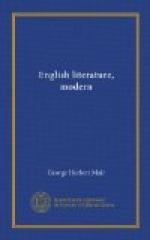He is an innovator in more ways than one. In the first place he is the earliest novelist to practise a conscious artistry of plot. The Mystery of Edwin Drood remains mysterious, but those who essay to conjecture the end of that unfinished story have at last the surety that its end, full worked out in all its details, had been in its author’s mind before he set pen to paper. His imagination was as diligent and as disciplined as his pen, Dickens’ practice in this matter could not be better put than in his own words, when he describes himself as “in the first stage of a new book, which consists in going round and round the idea, as you see a bird in his cage go about and about his sugar before he touches it.” That his plots are always highly elaborated is the fruit of this preliminary disciplined exercise of thought. The method is familiar to many novelists now; Dickens was the first to put it into practice. In the second place he made a new departure by his frankly admitted didacticism and by the skill with which in all but two or three of his books—Bleak House, perhaps, and Little Dorrit—he squared his purpose with his art. Lastly he made the discovery which has made him immortal. In him for the first time the English novel produced an author who dug down into the masses of the people for his subjects; apprehended them in all their inexhaustible character and humour and pathos, and reproduced them with a lively and loving artistic skill.
Dickens has, of course, serious faults. In particular, readers emancipated by lapse of time from the enslavement of the first enthusiasm, have quarrelled with the mawkishness and sentimentality of his pathos, and with the exaggeration of his studies of character. It has been said of him, as it has of Thackeray, that he could not draw a “good woman” and that Agnes Copperfield, like Amelia Sedley, is a very doll-like type of person. To critics of this kind it may be retorted that though “good” and “bad” are categories relevant to melodrama, they apply very ill to serious fiction, and that indeed to the characters




